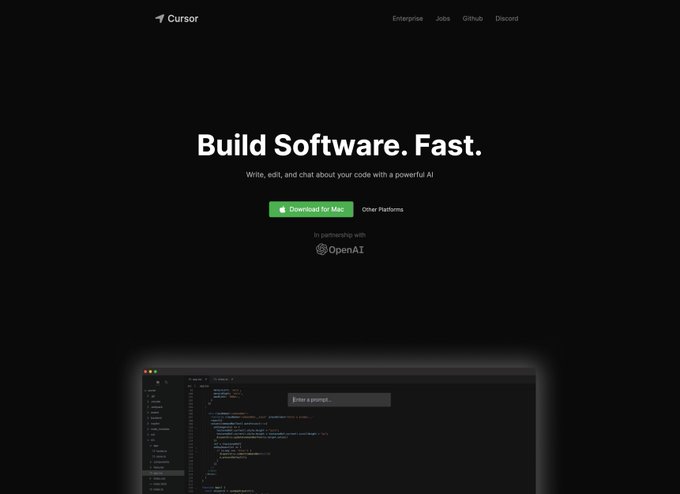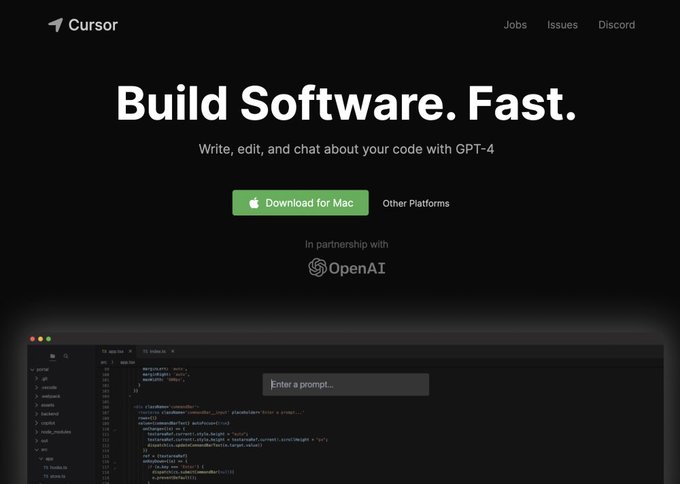Another week of explosive news. The coding assistant Cursor, the AI tool Adobe Firefly for designers, Google's ChatGPT "Bard," Bing Image Creator, and ChatGPT Plugins, among others, are overwhelming and causing anxiety.
Please refer to the following link for the previous week's news:
https://twitter.com/cryptonerdcn/status/1637732263709532160
March 20th
Cursor.so is released.
Cursor.so integrates GPT-4 and is an excellent and powerful free code generator similar to Github Copilot. It supports multiple programming languages and can automatically generate code snippets based on your input and requirements.
Its biggest feature is that it is free and integrates GPT-4, making its code quality higher than that of Github Copilot (which also integrates Github Copilot internally). Additionally, it integrates ChatGPT, allowing for direct Q&A on the interface. Unlike Github Copilot, which only supports VS Code, Cursor.so supports many mainstream IDEs.
Direct Q&A in the IDE
However, there is some bad news: according to @dotey, Cursor.so has removed the promotion of GPT-4 and is now using GPT-3.5.
如果Cursor只能使用GPT-3.5,那和Copilot相比毫无优势了! 刚去官网 cursor.so 看了一下,已经删除GPT-4的宣传语了。
March 21st
Adobe announces the release of Firefly.
Firefly is an AI drawing tool launched by Adobe, mainly used for image generation and artistic font effects. It can create images based on text prompts and provides hundreds of styles that can be adjusted.
AI Art Generator - Adobe Firefly
Text-generated image examples, similar to Midjourney
Text effects/artistic font examples
Application link:
There is also big news on this day: Google's Bard is officially in beta testing (although only available to users with US and UK IP addresses). According to various user reports, although it is slightly inferior to ChatGPT in English, it can still compete. The biggest issue is that it does not currently support multiple languages or code writing.
March 22nd
At GTC2023, NVIDIA announced the provision of cloud services for generative AI and released the NVIDIA H100 NVL optimized for LLM, which Huang referred to as being 10 times faster than the "only GPU that can actually handle ChatGPT," the HGX A100.
On the same day, Bing Image Creator was released. It is an online AI drawing tool launched by Microsoft based on artificial intelligence technology. It allows users to quickly generate images based on text descriptions. It is an advanced version based on OpenAI's DALL-E model and has been integrated into the new versions of Bing and Edge browsers.
Try Bing Image Creator without signing up:
March 23rd: Microsoft officially launches Microsoft Loop.
Microsoft Loop is a new collaborative canvas that allows teams to collaborate across Microsoft 365 applications. Loop's components, pages, and workspaces are built on Microsoft's Fluid Framework open-source platform.
It can be seen that Microsoft Loop is a direct competitor to Notion. They even have a similar AI, which was mentioned last week as Microsoft 365 Copilot:
https://twitter.com/cryptonerdcn/status/1637732318260654080?s=20
On the same day, Canva introduced ten AI capabilities to compete with Adobe Firefly.
March 24th
Big news! ChatGPT announces support for plugins!
Plugins are tools specifically designed for language models that help ChatGPT access the latest information, perform calculations, or use third-party services. This allows third-party developers to integrate their own services into ChatGPT's chat window. The first batch of open plugins includes hotel and flight booking, food delivery services, online shopping, legal knowledge, professional Q&A, and text-to-speech generation.
The most powerful plugin provided by OpenAI is the browsing plugin.
It uses the Bing search API to answer questions with the latest information from the internet and provides search steps and content source links. This means that ChatGPT, which was previously a fool with knowledge only up to 2021, now has the latest information from the internet (not really).
For developers:
Here is a development guide for the Plugin for ChatGPT.
As usual, this also requires joining the waitlist, and the link is here:
ChatGPT plugins waitlist (openai.com)
March 25th
Databricks has open-sourced an LLM called Dolly, which has the ability to follow instructions similar to ChatGPT, using only 6 billion parameters. Interestingly, this model is not newly developed.
Dolly has only 6 billion parameters, far fewer than GPT-3's 175 billion, and has been around for two years. Its outstanding performance is surprising. Its principle is to use an existing open-source 6 billion parameter model from EleutherAI and fine-tune it using Alpaca's data to give it the ability to follow instructions that the original model did not have.
Why is it an open model?
Databricks believes that models like Dolly will help promote LLM and make it something that every company can afford and customize to improve their products, rather than something only a few companies can afford. Most ML users can get the best long-term service by directly owning their models.
Repository link: https://github.com/databrickslabs/dolly
If this article is helpful, please subscribe and share. You can also follow me on Twitter. I will bring you more information about Web3, Layer2, AI, and Japan-related news:

